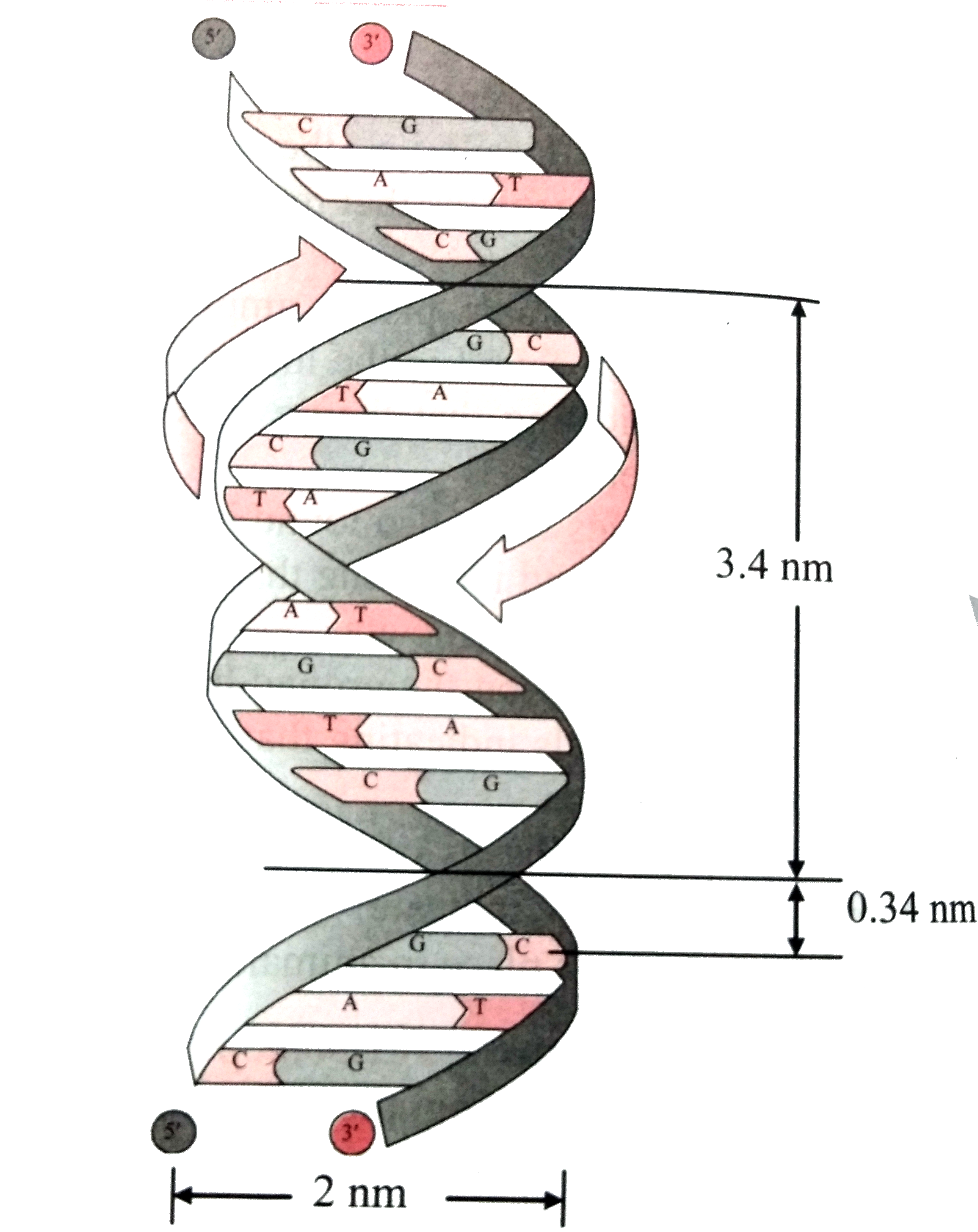Sketch and explain the strucute of DNA and various types of RNA.
Text Solution
a. Structure of DNA
1. In 1953, Watson and Crick proposed a model of the DNA molecule.
2. According to this model, the two threads (strands) ofnjcleotides coil around each other to form a double helix.
3. This double helical structure appears like a flexible ladder.
4. Each strand is made up molecules known as nucleotides.
5. A molecule of a nitrogenous base and phosphoric acid are joined to a molecule of sugar to form nucleotide.
6. There are four types of nitrogenous bases in the form of adeine and guanine (pruines), thymine and cytosine (pyrimidines). Thus, four types of nucleotides are formed.
7.The nitrogenous bases from the two strands are joined by hydrogen bonds toform base paris (rungs of ladder). Two threads form a long chain of alternately joined molecules of sugar and phosphoric acid (rails of the ladder).
8. The adenine always pairs with thymine and guanine always pairs with cytosine in a DNA molecule.

b. RNA
1. Structure of RNA:
The nucleotide is the smallest unit of the chain of the RNA molecule.
RNA nucleotide is made up of a ribose sugar, phosphate molecule and any one of the four types of nitrogenous bases adenine, guanine, cytosine and uracil.
Large number of nucleotides are bonded together to form the macromolecule of RNA.Depending uponi the function. RNA are classified into three types:

Ribosmal RNA (rNA): It is the component of cellurar organele, ribosome. Ribosomes prform the function of protein synthesis.
Messenger RNA (mRNA): It carries the information for protein synthesis from genes (i.e. DNA segment in the nucleus of cell) to the ribosome (in cytoplams of cell).
Transfer RNA (tRNA): It carries amino acid up to the ribosome according to the message on the mRNA.
|
Topper's Solved these Questions
- HEREDITY AND EVOLUTIONBOOK - TARGET PUBLICATIONCHAPTER - HEREDITY AND EVOLUTIONEXERCISE - INTERNET IS MY FRIEND
1 Videos
- HEREDITY AND EVOLUTIONBOOK - TARGET PUBLICATIONCHAPTER - HEREDITY AND EVOLUTIONEXERCISE - PROJECT
2 Videos
- HEREDITY AND EVOLUTIONBOOK - TARGET PUBLICATIONCHAPTER - HEREDITY AND EVOLUTIONEXERCISE - QUESTIONS BASED ON PARAGRAPH
1 Videos
- CELL BIOLOGY AND BIOTECHNOLOGY BOOK - TARGET PUBLICATIONCHAPTER - CELL BIOLOGY AND BIOTECHNOLOGY EXERCISE - Apply your knowledge
21 Videos
- INTRODUCTION TO MICROBIOLOGY BOOK - TARGET PUBLICATIONCHAPTER - INTRODUCTION TO MICROBIOLOGY EXERCISE - APPLY YOUR KNOWLEDGE
26 Videos
Similar Questions
Sketch and explain the structure of DNA and various type of RNA.
View SolutionExplain the types of RNA.
View SolutionExplain various types of products.
View SolutionExplain various types of senescence.
View SolutionExplain various types of immunization.
View SolutionExplain with examples the various types of systems.
View SolutionExplain with examples the various types of industries.
View SolutionExplain the various types of acquired immunity.
View SolutionDraw a labelled schematic sketch of replication fork of DNA. Explain the role of the enzymes involved in DNA replication
View SolutionDraw a labelled schematic sketch of replication fork of DNA. Explain the role of the enzymes involved in DNA replication
View Solution
